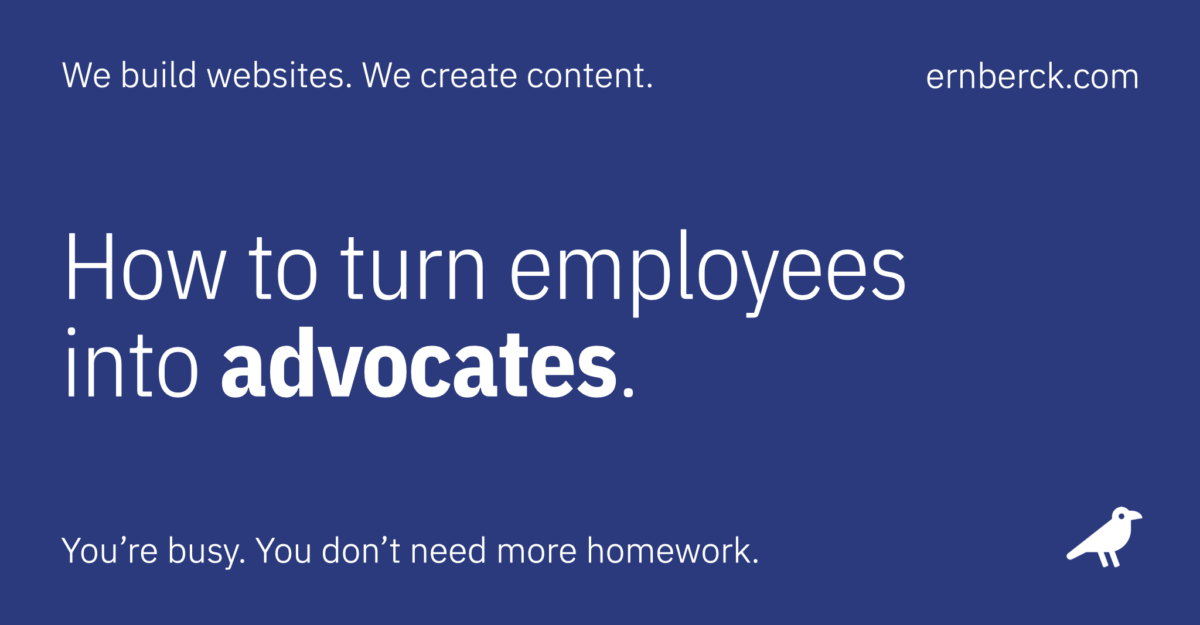Social media advocacy is a powerful strategy that encourages employees to actively promote their company on personal social media accounts. Executed properly, it can significantly improve a company’s reach and brand awareness.
What is social media employee advocacy?
“Social media employee advocacy” refers to the practice of employees actively promoting and supporting their company or brand on social media platforms. It involves empowering and encouraging employees to share company content, news, and updates on their personal social media accounts.
The goal of social media advocacy is to amplify the brand’s reach, increase visibility, and build a positive image through the authentic and genuine voices of employees.
Key aspects of social media advocacy
A successful social media employee advocacy program fosters a positive and supportive environment where employees genuinely want to participate in promoting their organization. Some key points to keep in mind are:
It’s crucial to strike a balance and avoid pressuring employees into advocacy. Participation should be voluntary, and employees should not feel obligated to share content if they are not comfortable doing so.
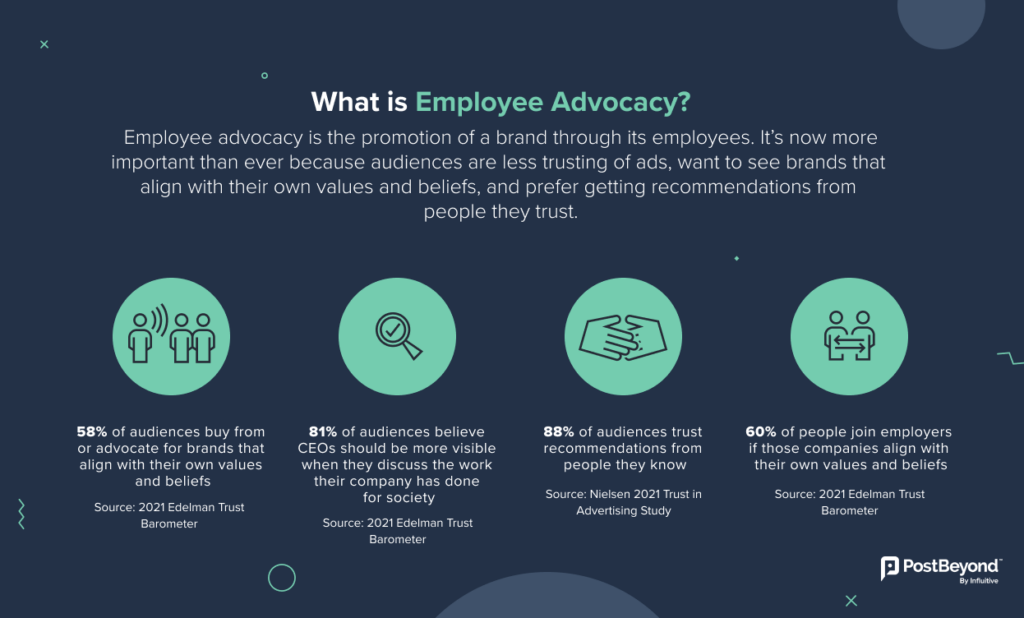
Improve your company’s reach
Social media employee advocacy can significantly improve a company’s marketing reach by leveraging the collective networks and influence of its employees. Here are some ways in which it can achieve this:
Expanded network reach
Each employee has their own network of connections on social media platforms. When they share company content or updates, it reaches not only their immediate followers but also those within their extended network. This creates a ripple effect, exponentially increasing the potential reach of the content.
Increased engagement
Content shared by employees tends to receive higher engagement rates compared to content shared by brand channels. People are more likely to interact with posts from individuals they know and trust, rather than posts from faceless corporate entities.
Humanizes the brand
Employee advocacy adds a human touch to the company’s online presence. It humanizes the brand by putting real faces and personalities behind the messages, making it more relatable and approachable to the audience.
Builds trust and credibility
Content shared by employees is seen as more authentic and trustworthy, as it is coming from someone who works within the company. This credibility can positively impact the perception of the company and its offerings.
Can reach niche audiences
Employees may belong to different industries, groups, or communities outside of their work environment. By sharing content, they can reach niche audiences that the company’s official channels might not have access to.
Amplify reach during events and campaigns
During important company events, product launches, or marketing campaigns, employees can play a crucial role in amplifying the company’s message and creating a buzz around the event.
Fosters word-of-mouth marketing
Social media employee advocacy is akin to word-of-mouth advertising, which is a powerful and influential form of marketing. When employees share positive experiences and stories about the company, it can lead to increased referrals and recommendations.
Boosts organic reach
As employee-shared content gains traction and engagement, social media algorithms may prioritize it, leading to increased organic (unpaid) visibility on platforms.
To ensure that social media advocacy is effective in improving a company’s reach, it’s essential for companies to provide the right training, guidelines, and support to their employees.
Advocacy should be a voluntary and positive experience that empowers employees to be brand ambassadors, rather than a forced or mechanical process. Companies should also track and measure the impact of employee advocacy efforts to identify successful strategies and continuously refine their approach.
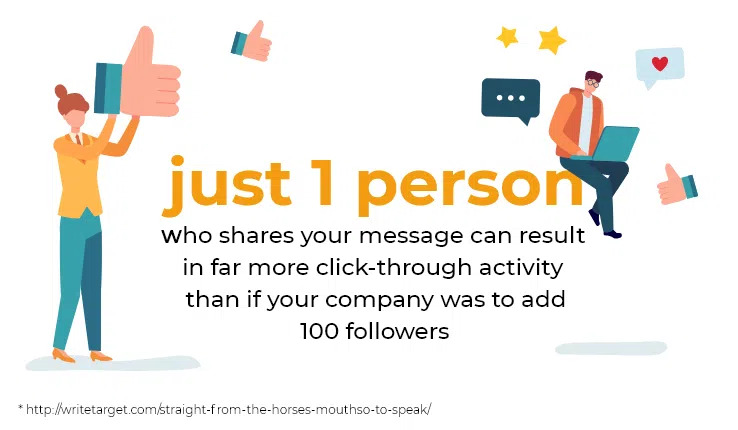
Generate brand awareness
Social media employee advocacy can significantly help generate brand awareness for a company. When employees become brand advocates and actively participate in sharing company-related content on their personal social media profiles, it can lead to several benefits that contribute to increased brand awareness. Here’s how social media employee advocacy helps in generating brand awareness:
Expanded reach
Employees have their own networks on social media, which can be significantly larger than the company’s official social media following.
When employees share content, it reaches not only their immediate connections but also their extended networks, effectively increasing the reach of the brand’s messages.
Authenticity and credibility
Content shared by employees comes across as more authentic and trustworthy to the audience. People tend to trust personal connections more than corporate advertisements.
By having employees share their positive experiences and perspectives about the brand, it enhances the credibility of the messages.
Humanizing the brand
Employee advocacy puts a human face on the brand. It showcases that the company is made up of real people who are passionate about their work.
This humanization resonates with the audience and helps build stronger connections with potential customers.
Engagement and interaction
Content shared through employee advocacy often receives higher engagement rates. People are more likely to interact with posts from individuals they know and trust — Leading to increased comments, likes, and shares.
Tap into niche audiences
Employees belong to various communities and groups beyond their work environment. By sharing content, they can reach niche audiences that the company’s official channels might not have access to.
Word-of-mouth marketing
Social media employee advocacy functions like word-of-mouth marketing. When employees share their positive experiences, it can lead to increased referrals and recommendations, further expanding brand awareness.
Impact during events and campaigns
During important events, product launches, or marketing campaigns, employees can significantly amplify the company’s message, creating more buzz and awareness around the event.
Consistent brand messaging
By encouraging employees to share company-approved content, it ensures that brand messaging is consistent across various social media profiles, reinforcing the key brand attributes and values.
Competitive advantage
Companies with active social media employee advocacy programs can stand out from their competitors. An engaged and enthusiastic workforce promoting the brand can positively influence potential customers’ perception of the company.
Overall, social media employee advocacy can be a powerful tool in generating brand awareness. However, it’s essential to provide employees with the right guidance and resources to ensure that the content shared aligns with the company’s messaging and objectives. Creating a positive and supportive culture around employee advocacy can lead to more significant brand visibility and increased awareness in the long run.
Employee advocacy in daily life
The following examples demonstrate how social media employee advocacy can take different forms across various platforms. The central theme is to leverage the genuine enthusiasm and pride of employees to boost the company’s online presence and engage a broader audience.
- A company launches a new product and the marketing team creates engaging posts with images and videos to promote it.
- They encourage employees to share these posts on their personal Facebook profiles with a personalized message about why they are excited about the product.
- This amplifies the product launch message, reaching a wider audience through the employees’ networks.
- An organization hosts an employee appreciation event, and the human resources department captures fun moments and candid photos during the event.
- They create an Instagram post series, featuring individual employee photos with heartwarming captions expressing gratitude.
- Employees are encouraged to repost these images and share their own experiences using a unique event hashtag.
- During an industry conference or trade show, employees attend various sessions and gather valuable insights.
- They live-tweet interesting quotes, statistics, and key takeaways from the event using the company’s Twitter handle and relevant event hashtags.
- This not only engages the company’s audience but also positions the employees as industry thought leaders.
- A company publishes a thought leadership article written by its CEO on LinkedIn.
- The marketing team shares the article on the company’s LinkedIn page.
- Company employees are encouraged to share the article on their individual profiles, emphasizing the CEO’s expertise and the company’s commitment to industry leadership.
Cross-platform advocacy
- A company hosts a charity event to support a cause.
- They create content, including images and videos, showcasing the event’s impact and how employees are actively involved.
- Employees share this content across multiple social media platforms — such as Facebook, Instagram, Twitter, and LinkedIn — to demonstrate the company’s commitment to corporate social responsibility, and to engage their diverse network of connections.
Behind-the-scenes insights
- A company is working on an exciting project or developing a new feature for its product.
- Employees share behind-the-scenes photos and videos on Instagram Stories, providing glimpses of the team’s efforts and collaboration.
- This humanizes the company’s brand and generates interest in the upcoming release.
Employee spotlights
- On LinkedIn, the HR department regularly posts employee “spotlights,” where they highlight the accomplishments and contributions of different employees.
- Colleagues are encouraged to reshare these posts, showcasing a positive work culture and building a sense of camaraderie among employees.
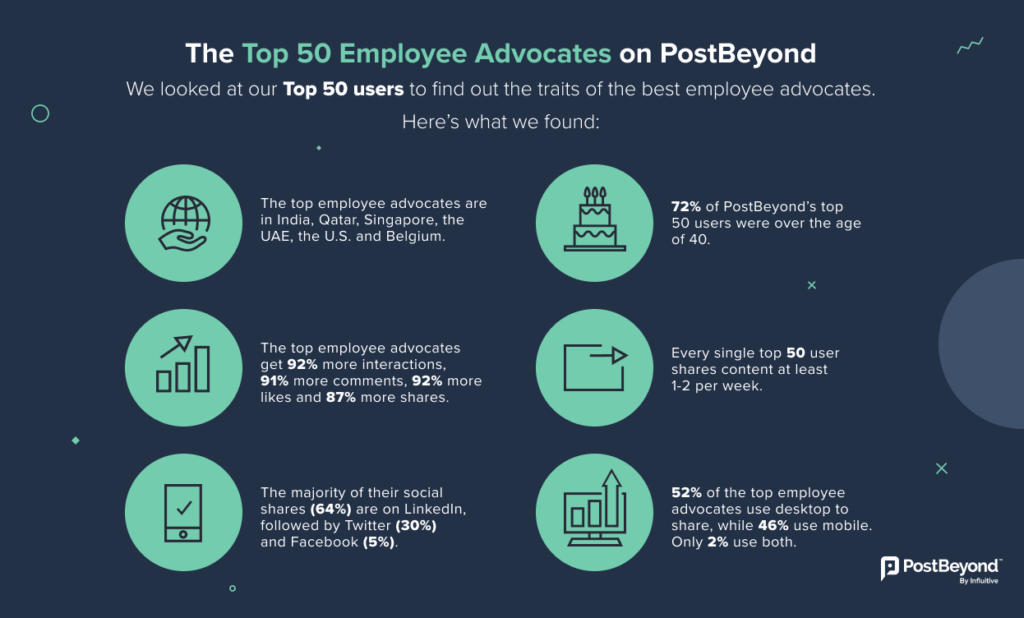
Turning employees into advocates
It’s unlikely that all of your employees will become willing and enthusiastic social media advocates for your business. That’s okay. The following guidelines can help turn even the most reluctant employee into a powerful ally.
By following these suggestions, companies can create a culture of social media advocacy, where employees feel empowered to share content and become enthusiastic brand ambassadors, positively impacting the company’s online presence and reach.
What makes a good advocate?
The most important quality of an employee advocate is authenticity. Authenticity refers to the genuine and sincere representation of the company and its values by the employee. When an employee advocate is authentic, they embody the following key characteristics:
Authenticity matters
Why authenticity is crucial for employee advocates:
It’s important for companies to nurture and support authentic employee advocates by providing the right training, resources, and freedom to share their unique perspectives.
Authentic employee advocacy benefits both the company and the advocates themselves, contributing to a positive brand image and an empowered workforce.
Employees also benefit
Participating in a social media advocacy program can offer several benefits to employees, enhancing their personal and professional growth. Here are some ways in which employees can benefit from being involved:
Professional development
Through social media advocacy, employees can improve their communication skills, content creation abilities, and social media marketing knowledge. This experience can be valuable for their career development, especially if they have aspirations in marketing, public relations, or communications roles.
Enhanced personal branding
Advocating for the company can also contribute to employees’ personal branding. By sharing insightful content and being associated with a reputable brand, they can build credibility within their professional network.
Networking opportunities
As employees share content and engage with others on social media, they have the chance to connect with industry peers, influencers, and potential clients or customers. These connections can lead to new opportunities and collaborations.
Increased visibility
Social media advocacy can lead to increased visibility for employees. Their posts and interactions can reach a broader audience, potentially attracting recognition from colleagues, management, or industry professionals.
Sense of purpose
Advocating for a company they believe in gives employees a sense of purpose and pride in their work. Knowing that they contribute to the company’s success beyond their daily tasks can boost their motivation and job satisfaction.
Leadership opportunities
As employees become active advocates, they may be recognized as leaders within the organization. This could lead to opportunities to take on additional responsibilities or to participate in leadership programs.
Learning industry trends
Engaging in social media advocacy often requires staying updated with industry news and trends. As employees curate and share content, they naturally stay informed about relevant developments in their field.
Positive company culture
Social media advocacy fosters a culture of collaboration and support within the company. Employees working together to promote the company can create a positive and cohesive team environment.
Recognition and rewards
Companies often acknowledge and reward employees who actively participate in advocacy efforts. Recognition can range from public appreciation to tangible incentives, reinforcing their contribution to the organization’s success.
Impact on the company
Employees see the direct impact of their advocacy efforts on the company’s success. This knowledge can create a strong sense of ownership and accountability, driving them to perform at their best.
In general, social media advocacy can be a mutually beneficial endeavor for both employees and the company. By empowering and encouraging employees to be brand advocates, companies can harness the power of authentic and engaged voices to boost brand awareness and reputation while simultaneously nurturing employee growth and job satisfaction.
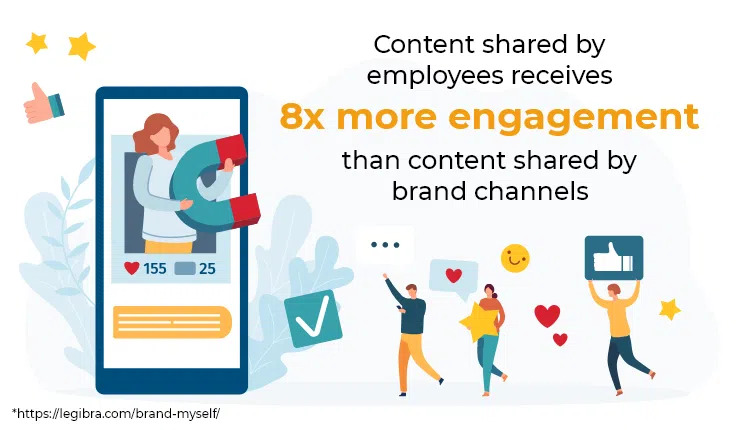
How to set up an advocacy program
Setting up a successful social media employee advocacy program involves careful planning, clear guidelines, and effective communication. Here are the essential steps to establish such a program:
01. Define objectives and goals
Determine the objectives of the advocacy program. Identify specific goals, such as increasing brand awareness, expanding reach, driving website traffic, or improving engagement on social media.
02. Secure leadership support
Gain support from top management or key stakeholders. A successful advocacy program requires support and buy-in from leadership to ensure adequate resources and commitment.
03. Create guidelines and policies
Develop clear and comprehensive guidelines for employees participating in the program. These guidelines should cover content sharing, branding, tone, appropriate use of hashtags, disclosure of affiliation with the company, and data privacy considerations.
04. Select social media platforms
Decide which social media platforms are most suitable for the advocacy program based on the company’s target audience and industry. Common platforms include Facebook, Twitter, LinkedIn, and Instagram.
05. Identify advocates
Identify and invite employees who are enthusiastic about the company and its products/services to participate voluntarily. Some employees may naturally be more active on social media and willing to become advocates.
06. Training and education
Provide training sessions or workshops to educate advocates about the program’s goals, social media best practices, and adherence to company guidelines. Ensure they understand the value of advocacy and how it benefits both the company and themselves.
07. Content creation
Develop a repository of engaging and shareable content that advocates can readily access and share. Content can include blog posts, infographics, videos, event updates, company news, and thought leadership articles.
08. Advocacy platform
Consider using a social media advocacy platform to facilitate content sharing, track engagement, and provide analytics. Such platforms can streamline the process and make it easier for employees to participate.
09. Launch the program
Announce the program to all employees and officially launch it with a kick-off event or internal communications. Encourage participation and share success stories from early advocates.
10. Recognize and reward
Acknowledge and reward advocates who actively participate in the program. Publicly recognize their efforts, highlight their contributions, and provide incentives or rewards to encourage continued engagement.
11. Monitor and measure
Continuously monitor the performance of the program using analytics. Track metrics such as reach, engagement, website traffic, and lead generation to assess the program’s impact and identify areas for improvement.
12. Provide ongoing support
Offer ongoing support and resources to advocates. Keep them updated on new content, provide assistance when needed, and address any questions or concerns promptly.
13. Adapt and improve
Regularly review and assess the program’s effectiveness. Gather feedback from advocates and make necessary adjustments to ensure the program continues to achieve its objectives.
Remember that social media employee advocacy should be voluntary, and employees should not feel pressured to participate. Foster a positive and supportive culture that encourages employees to be authentic advocates, sharing their passion for the company with their networks.
Summary
Social media employee advocacy is a powerful strategy where employees actively promote their company on personal social media accounts. It can significantly improve a company’s reach and brand awareness.
Advocacy involves voluntary participation, with employees genuinely passionate about their organization. By sharing content, employees expand the brand’s network, engaging with authentic and trustworthy messages.
This engagement humanizes the brand, building trust and credibility with the audience. Employees can reach niche audiences, enhancing word-of-mouth marketing and boosting organic reach.
Advocacy benefits employees too, as they develop professionally and build personal branding. They gain networking opportunities, visibility, and engagement, fostering a sense of purpose and job satisfaction.
Establishing an advocacy program involves defining objectives, securing leadership support, setting guidelines, selecting platforms, and identifying advocates. Providing training, content, and recognition ensures ongoing success.
Monitoring and adapting the program continuously improve its effectiveness. Authenticity remains the cornerstone of successful social media employee advocacy, empowering employees and elevating the brand.
Related
- Social media marketing
- Social proof explained
- Dark social media
- How to promote your website
- The truth about social media engagement
- A Facebook page is not a website
Sources
- Hootsuite: How To Create a Strong Social Media Advocacy Program
- Sociabble: A New Employee Advocacy Definition: The Ultimate Guide
Content
- Assisted by ChatGPT
